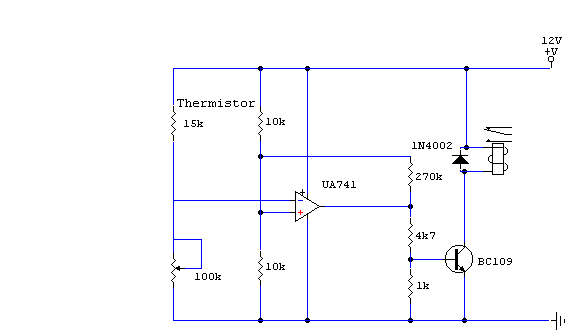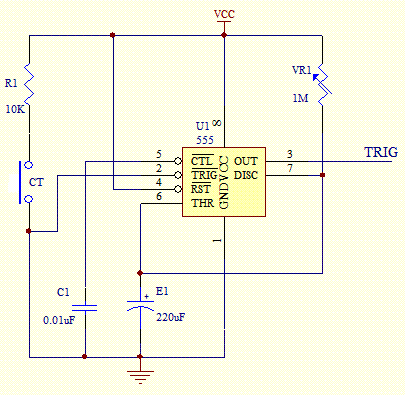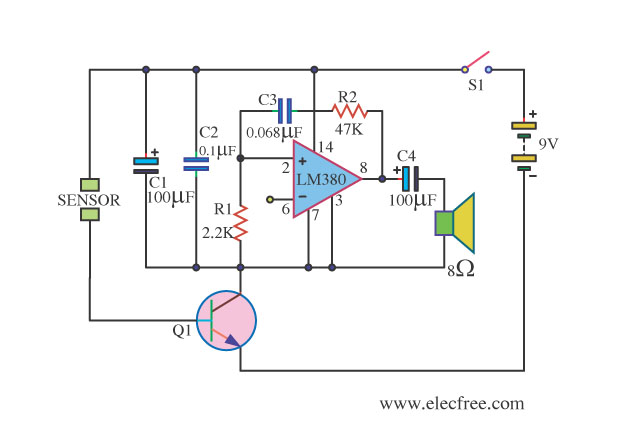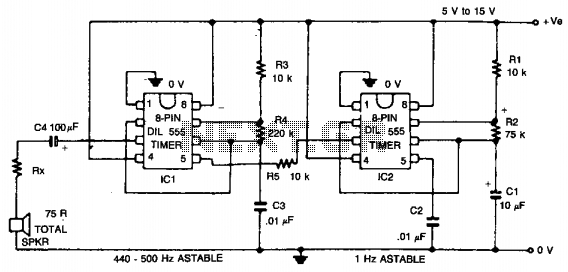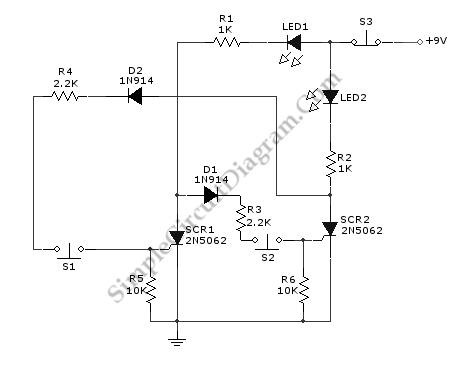
cmos 4060 burglar alarm
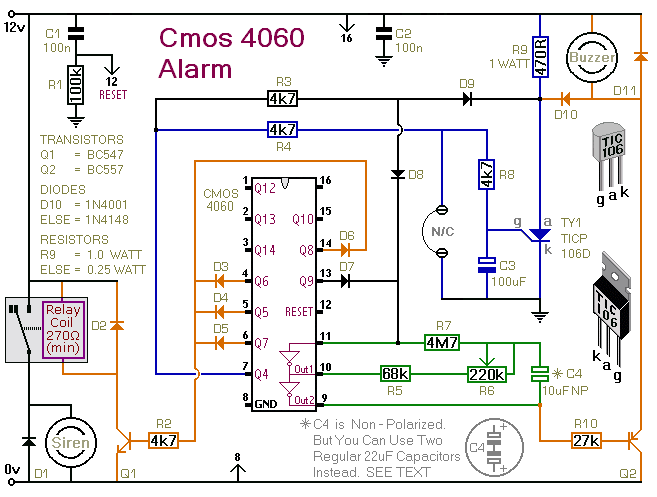
This is a single-zone alarm system equipped with automatic exit, entry, and siren cut-off timers. It is designed to accommodate various types of normally-closed input devices, including magnetic reed contacts, foil tape, and passive infrared sensors (PIRs). Additionally, it is straightforward to incorporate a normally-open trigger. When the alarm is activated, the siren will sound for a predetermined duration before automatically turning off and remaining inactive. The alarm system will not reactivate after the siren has been silenced. This circuit serves as a practical introduction to the CMOS 4060 and the silicon-controlled rectifier (SCR).
The described single-zone alarm system utilizes a CMOS 4060 integrated circuit, which functions as a timer and oscillator. The CMOS 4060 is a versatile component that allows for the generation of precise timing intervals, making it ideal for automatic exit and entry delays. It operates by producing a square wave output that can be adjusted through external resistors and capacitors, determining the timing for the siren cut-off.
The alarm system accepts inputs from various normally-closed devices, which are connected to the input terminals of the CMOS 4060. These devices, such as magnetic reed contacts and PIRs, are commonly used in security applications to detect unauthorized entry. The inclusion of a normally-open trigger enhances the system's flexibility, allowing it to integrate with additional sensors or switches that may be employed in specific scenarios.
Upon activation, the alarm triggers the SCR, which is used to drive the siren. The SCR is a semiconductor device that acts as a switch, allowing current to flow through the siren only when it is triggered. Once the siren is activated for the set duration, the timer within the CMOS 4060 will disable the SCR, silencing the siren and preventing any reactivation until the system is reset.
The design of this alarm system emphasizes simplicity and reliability, making it suitable for various applications where security is a priority. It provides an effective introduction to fundamental electronic principles, including timer circuits, input device integration, and the operation of SCRs in alarm systems.This is a single zone alarm - with automatic exit, entry and siren cut-off timers. It will accommodate all the usual types of normally-closed input devices - such as magnetic reed contacts, foil tape, PIRs etc. But it`s easy to add a normally-open trigger. When the alarm is activated - the siren will sound for a fixed length of time. Then it will switch off - and remain off. The alarm will not reactivate. The Circuit offers a good introduction to the Cmos 4060 and the SCR.. 🔗 External reference
The described single-zone alarm system utilizes a CMOS 4060 integrated circuit, which functions as a timer and oscillator. The CMOS 4060 is a versatile component that allows for the generation of precise timing intervals, making it ideal for automatic exit and entry delays. It operates by producing a square wave output that can be adjusted through external resistors and capacitors, determining the timing for the siren cut-off.
The alarm system accepts inputs from various normally-closed devices, which are connected to the input terminals of the CMOS 4060. These devices, such as magnetic reed contacts and PIRs, are commonly used in security applications to detect unauthorized entry. The inclusion of a normally-open trigger enhances the system's flexibility, allowing it to integrate with additional sensors or switches that may be employed in specific scenarios.
Upon activation, the alarm triggers the SCR, which is used to drive the siren. The SCR is a semiconductor device that acts as a switch, allowing current to flow through the siren only when it is triggered. Once the siren is activated for the set duration, the timer within the CMOS 4060 will disable the SCR, silencing the siren and preventing any reactivation until the system is reset.
The design of this alarm system emphasizes simplicity and reliability, making it suitable for various applications where security is a priority. It provides an effective introduction to fundamental electronic principles, including timer circuits, input device integration, and the operation of SCRs in alarm systems.This is a single zone alarm - with automatic exit, entry and siren cut-off timers. It will accommodate all the usual types of normally-closed input devices - such as magnetic reed contacts, foil tape, PIRs etc. But it`s easy to add a normally-open trigger. When the alarm is activated - the siren will sound for a fixed length of time. Then it will switch off - and remain off. The alarm will not reactivate. The Circuit offers a good introduction to the Cmos 4060 and the SCR.. 🔗 External reference
Warning: include(partials/cookie-banner.php): Failed to open stream: Permission denied in /var/www/html/nextgr/view-circuit.php on line 713
Warning: include(): Failed opening 'partials/cookie-banner.php' for inclusion (include_path='.:/usr/share/php') in /var/www/html/nextgr/view-circuit.php on line 713
